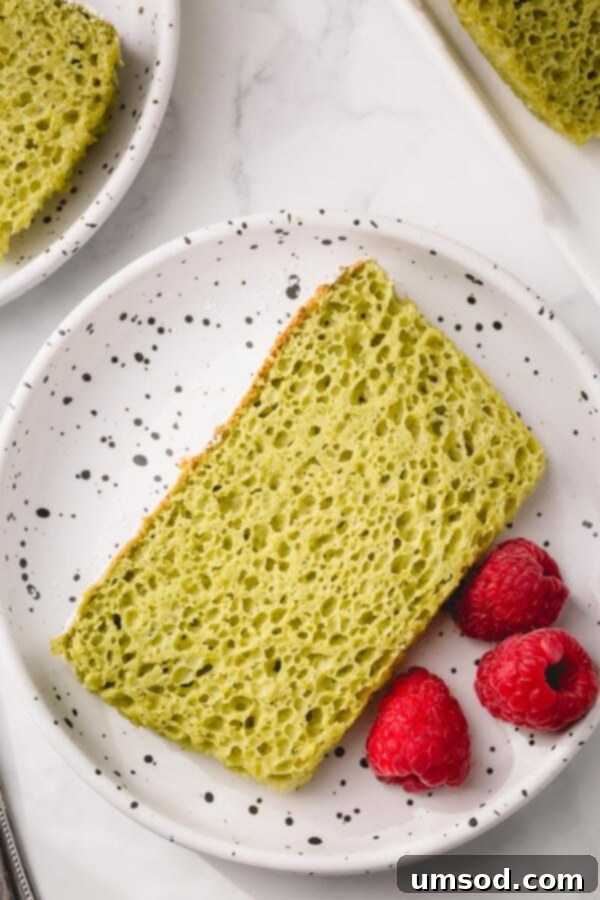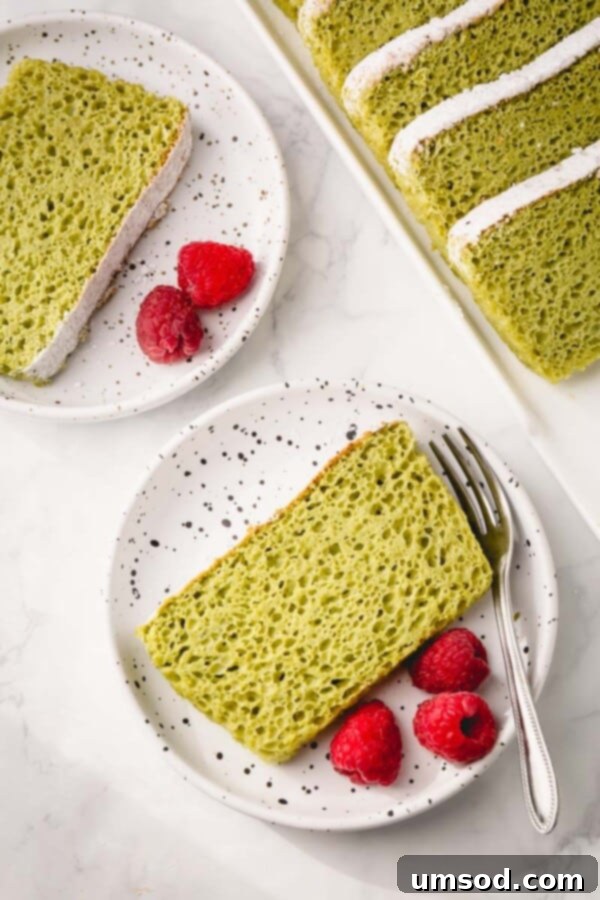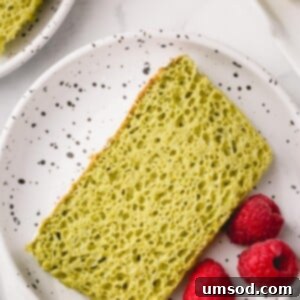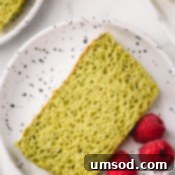Step into the delightful world of Japanese-inspired baking with our incredibly soft, fluffy, and moist Matcha Sponge Cake. This exquisite green tea cake, infused with the subtle, earthy sweetness of premium matcha powder, is a true testament to simple elegance. Perfect for any occasion, from a quiet afternoon tea to a special gathering, its vibrant natural green hue and delicate flavor are sure to enchant.

Why You’ll Fall in Love with This Matcha Sponge Cake
If you’re searching for a dessert that’s both impressive and effortlessly simple, look no further. This no-fuss green tea sponge cake is a revelation, offering a lighter, subtly flavored alternative to richer desserts. It’s essentially a scaled-down version of a classic angel food cake, enhanced with the unique characteristics of matcha. You’ll adore this cake for several compelling reasons:
- Unrivaled Texture: Experience a cake that is delicately soft, incredibly fluffy, and boasts a wonderfully moist crumb that practically melts in your mouth. Unlike some sponge cakes, it retains its tender quality long after baking.
- Sublime, Balanced Flavor: Enjoy a cake that is perfectly sweet without being overwhelming. The earthy, slightly bittersweet notes of high-quality matcha powder shine through, creating a sophisticated and harmonious taste profile that is truly unique.
- Effortless Preparation: Don’t let its elegant appearance fool you; this recipe is surprisingly simple to prepare. With just a handful of common ingredients and no need for elaborate techniques or specialized equipment, it’s accessible for bakers of all skill levels.
- Naturally Beautiful: The stunning, vibrant green color of this cake comes entirely from the matcha itself. There’s no need for artificial food colorings, allowing the natural beauty of the ingredients to speak for itself.

Understanding Matcha: The Heart of Your Green Tea Cake
Matcha, pronounced “MAH-chah,” is much more than just green tea; it’s a finely ground powder made from specially cultivated and processed green tea leaves. Originating from Japan, matcha has been revered for centuries in traditional tea ceremonies for its unique flavor and health benefits. Unlike regular green tea, where the leaves are steeped and then discarded, with matcha, you consume the entire tea leaf, receiving a more concentrated dose of its flavor and nutrients.
I often incorporate matcha into my baking because it infuses cakes with a very subtle yet distinct flavor profile, a delightful blend of earthy notes with a hint of natural sweetness. The most striking benefit, however, is the gorgeous, all-natural green color it imparts. As you can see, absolutely no food coloring is added to achieve this vibrant hue!
The key to a truly exceptional matcha sponge cake lies in the quality and freshness of your matcha powder. Matcha tea doesn’t retain its peak quality for extended periods, especially once opened. Using an old or low-grade matcha powder will result in a duller color and a less pronounced, sometimes even fishy, flavor, which will significantly diminish the cake’s appeal.
For this recipe, I highly recommend using a culinary grade matcha. While ceremonial grade matcha is fantastic for drinking on its own, culinary grade is specifically formulated to hold its flavor and color well when mixed with other ingredients and exposed to heat, making it perfect for baking. Always store your matcha in an airtight container in a cool, dark place, or even in the refrigerator, to preserve its freshness.

The Simple Steps to Baking Your Perfect Matcha Sponge Cake
Creating this green tea sponge cake is incredibly straightforward and requires minimal effort. You won’t need any special equipment beyond standard kitchen tools, making it an ideal recipe for both novice and experienced bakers alike. Plus, with just four main ingredients (plus a pinch of salt), you’ll be amazed at the sophisticated results.
For this specific recipe, a basic loaf pan is all you need. The beauty of this cake is its forgiving nature and straightforward process. Let’s walk through each step to ensure your matcha sponge cake turns out perfectly light and airy every time.
- Prepare Your Dry Ingredients: In a medium bowl, thoroughly sift together the cake flour, matcha powder, and salt. Sifting is a crucial step that helps remove any lumps from the flour and matcha, ensuring a smoother batter and a finer, more tender cake crumb. It also helps to evenly distribute the matcha powder, preventing streaks of concentrated color.
- Whip the Egg Whites to Perfection: In a large, impeccably clean mixing bowl, begin whipping your egg whites on a low speed until they become foamy. Once they reach a consistent foamy texture, gradually start adding the granulated sugar, one tablespoon at a time, while continuously beating the egg whites. Increase the speed to medium-high and continue beating until stiff, glossy peaks form. The meringue should hold its shape firmly when the whisk is lifted.
- Gently Fold in the Dry Mixture: Carefully sift the prepared flour mixture over the whipped egg whites. Using a spatula, gently fold the dry ingredients into the meringue. The key here is to be very delicate and avoid overmixing. Overmixing will deflate the beautifully aerated egg whites, resulting in a dense and heavy cake. Aim to fold just until the ingredients are combined, leaving no streaks of flour.
- Transfer and Bake: Pour the batter evenly into your ungreased loaf pan. Do not grease or line the pan, as the batter needs to cling to the sides to rise properly. Once the batter is in the pan, run a thin butter knife or skewer through it a few times to release any large air pockets. This helps prevent large holes in the final cake. Bake for approximately 25 to 30 minutes, or until a wooden skewer or toothpick inserted into the center comes out completely clean.
- Cool Upside Down: This is a critical step for preventing your sponge cake from collapsing. Immediately after removing it from the oven, invert the loaf pan and cool the cake upside down until it is completely cool. You can achieve this by resting the edges of the pan on two elevated surfaces (like canning jars or sturdy cups), allowing air to circulate freely around the cake. This method supports the delicate structure of the cake as it cools, maintaining its volume and light texture.
- Effortless Removal: Once the cake is fully cooled, run a thin knife gently along the edges of the pan to loosen it. Then, carefully peel the cake out of the pan. It should release easily, leaving you with a perfectly shaped matcha sponge cake.

Expert Tip: Prevent Your Cake from Collapsing
Cooling your matcha sponge cake upside down is a non-negotiable step to maintain its airy structure and prevent it from deflating. This technique ensures that gravity works in your favor, stretching the fragile cell walls of the cake as it cools and sets. Always allow ample room for air to circulate freely around the inverted cake for proper and even cooling.
Essential Tips for a Flawless Matcha Sponge Cake Every Time
Achieving a perfectly light and ethereal matcha sponge cake is within your reach with these expert tips:
- The Golden Rule for Egg Whites: A Grease-Free Zone: When whipping egg whites, it is absolutely paramount that your mixing bowl and whisk are immaculately clean and completely free of any grease or fat residue. Even a tiny speck of egg yolk or oil can prevent the egg whites from whipping up properly, hindering them from reaching stiff peaks. For a deeper dive into this essential technique, check out my Meringue 101 video.
- The Magic of Cake Flour: Cake flour is key to the incredibly light and fluffy texture of this sponge cake. Its lower protein content produces less gluten, resulting in a more tender and delicate crumb compared to all-purpose flour. If you don’t have cake flour on hand, don’t worry – you can easily make your own. (See the DIY Cake Flour section below!)
- Fresh Matcha is Non-Negotiable: The quality of your matcha directly impacts the flavor and color of your cake. Always use fresh matcha powder. Matcha that has been opened for more than two months, or has been improperly stored, can quickly lose its vibrant color and unique flavor, leading to a dull-looking and bland-tasting cake. Invest in good culinary-grade matcha and store it correctly.
- Gentle Folding is Key: After whipping your egg whites, the goal is to preserve as much air as possible. When incorporating the dry ingredients, use a gentle folding motion with a spatula, cutting through the center and folding up from the bottom. Avoid aggressive stirring or overmixing, which will deflate the meringue and result in a dense cake.
- Don’t Overbake: Overbaking can lead to a dry cake. Start checking for doneness at the lower end of the recommended baking time. A toothpick inserted into the center should come out clean, but avoid baking until the cake feels hard or overly firm.

DIY Cake Flour: A Quick and Easy Substitute
No cake flour in your pantry? No problem! You can easily create a substitute with all-purpose flour and cornstarch. For this recipe, which calls for 1/2 cup of cake flour, here’s how to make your own:
Measure out 1/2 cup of all-purpose flour. Then, remove exactly 1 tablespoon of that flour. Replace the removed tablespoon with 1 tablespoon of cornstarch. Finally, sift this mixture together at least once (preferably twice) to ensure the cornstarch is evenly distributed. And just like that, you have a homemade cake flour substitute ready to create a wonderfully tender crumb!
Serving Suggestions: Elevating Your Matcha Cake Experience
This matcha sponge cake is a fantastic everyday treat, and its versatility allows for numerous delicious serving options. While it’s delightful on its own, a few simple additions can elevate it to a dessert perfect for any occasion:
- Simple Elegance: My personal favorite way to enjoy this cake is dusted with a light cloud of powdered sugar and accompanied by a handful of fresh berries. The tartness of raspberries, strawberries, or blueberries beautifully complements the earthy sweetness of the matcha.
- Creamy Indulgence: For an extra touch of decadence, serve slices of cake with a dollop of homemade whipped cream. The light and airy cream provides a wonderful textural contrast.
- Fruity Pairings: Beyond berries, consider serving it with thinly sliced kiwi, mango, or even a light fruit compote.
- Aromatic Companions: This cake pairs wonderfully with a warm beverage. Enjoy it alongside a cup of traditional Japanese green tea, a matcha latte, or a simple coffee.
- Ice Cream Delight: For a more dessert-like experience, a scoop of vanilla bean ice cream or even green tea ice cream alongside a slice of matcha sponge cake makes for a delightful treat.

Whether enjoyed simply or adorned with delicious accompaniments, this matcha sponge cake is a delightful way to bring the unique flavors of green tea into your home baking. Enjoy every tender, flavorful bite!

Matcha Sponge Cake
Shinee Davaakhuu
Delicately soft and fluffy, this matcha sponge cake with earthy sweet green tea powder is a perfect everyday cake.
45 mins
6 servings
Comment
Print Recipe
Ingredients
- 1/2 cup (65g) cake flour Note 1
- 2 tablespoons matcha powder Note 2
- 1/4 teaspoon coarse kosher salt
- 6 egg whites Note 3
- 3/4 cup (150g) granulated sugar
Instructions
Preheat the oven to 325°F (160°C).
Sift together cake flour, matcha powder and salt.
In a large mixing bowl, beat the egg whites until foamy on a low speed. When the egg whites get white and foamy, start adding sugar one tablespoon at a time. Continue to beat on medium high speed until stiff peaks form.
Add flour mixture and carefully fold everything together. Be careful not to deflate the batter much.
Transfer the batter to an ungreased loaf pan. Even out the surface. Run a butter knife through the batter to remove any large air pockets. Bake for 25-30 minutes, or until the inserted wooden stick comes out clean.
Cool the cake upside down until completely cooled. Allow plenty of room to circulate air around the cake. This will prevent the cake from collapsing.
To remove the cake from the pan, run a knife along the edges of the pan and then gently peel it out of the pan.
Dust powdered sugar over the cake and serve with fresh berries or whipped cream, if desired.
⭐️ Did you make this recipe?
Please leave a review and let us know how you liked it!
Tips & Notes
Note 1: To make DIY cake flour, measure out 1/2 cup of all-purpose flour, remove 1 tablespoon of it and add 1 tablespoon of cornstarch. Sift and you have a DIY cake flour!
Note 2: Make sure to use fresh matcha powder. Old matcha powder that’s been opened for more than 2 months looses its quality and will produce a cake with dull color and won’t add matcha flavor.
Note 3: I’ve used carton egg whites with success. You’ll need 210g of liquid egg whites.
Nutrition
165kcal
33g
7g
1g
25g
147mg
Dessert
American

Leave a rating and your feedback. Thank you!
